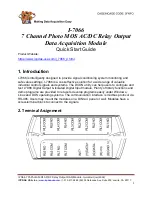
3. Turn the front panel Master Control Switch
to the STOP position or deactivate the electrical
master enable input (see "Electrical I/O" in the
"Installation" section of this manual). This will
disable speed control to all rotators.
4. Turn the front panel Power ON/OFF switch to
the OFF position. This will disable speed control
to all rotators. This should be used as a last resort.
The above methods are preferred over this one.
FAULT DESCRIPTIONS
Atomizer Card
The PulseTrack 2 system performs a number of
operational diagnostics and will automatically stop
a rotator in the event that an unsafe or abnormal
condition exists. The possible rotator speed
faults are listed below. These fault conditions
are also supplied through remote output signals
(see "Electrical I/O" in the "Installation" section
of this manual).
Over Speed - oS
When this fault occurs “oS” is displayed on the
speed display of the Atomizer Card. In addition,
the Master Overspeed, Master Fault and corre-
sponding Rotator Fault outputs turn on. For bell
rotators, this fault occurs when the rotator speed
exceeds the setpoint by 10,000 rpm. For disk
rotators, this fault occurs if the disk speed becomes
greater than 45,000 rpm.
Under Speed - uS
(not used for disk rotators)
When this fault occurs “uS” is displayed on the
speed display of the Atomizer Card. In addition,
the Master Underspeed, Master Fault and corre-
sponding Rotator Fault outputs turn on. For bell
rotators, this fault occurs when the rotator speed
is less than the setpoint by 10,000 rpm or more.
Loss of Feedback - LF
When this fault occurs “LF” is displayed on the
speed display of the Atomizer Card. In addition,
the Master LOF, Master Fault and corresponding
Rotator Fault outputs turn on. This fault occurs
when speed control is active and the microcon-
troller detects that no speed feedback signal is
present. When the rotator is spinning, the fiber
optic cable sends pulses of light back to the Fiber
Optic Receiver Module located in the PulseTrack
2 control panel. The Fiber Optic Receiver Module
converts these light pulses to electrical pulses
which are then sent to the microcontroller for
processing. If no pulses are detected by the mi-
crocontroller and speed control is active, a Loss
of Feedback fault occurs.
Invalid Speed Request - In
This fault occurs when the speed setpoint is set
to a value that exceeds the maximum speed of a
given rotator. In addition, the corresponding Rota-
tor Fault output turns on. When this fault occurs,
the rotator keeps spinning at the last acceptable
speed and “In” flashes alternately in the speed
display along with the current speed. When the
setpoint is reduced below maximum, the rotator
begins spinning at the new speed, “In” is removed
from the speed display and the corresponding
Rotator Fault output turns off.
Optional Temperature/Humidity
Card
No Connection - nc
This fault occurs when the microcontroller detects
a loss of either the temperature or humidity 4 -
20 mA signal. When the temperature/humidity
switch is in the position of the lost signal, “nc” will
be shown on the temperature/humidity display. If
both signals are lost (unconnected or cut cable)
“nc” will be shown in both switch positions.
Summary of Contents for Pulsetrack 2
Page 13: ...Figure 1 Typical Turbodisk 2 Installation With Temperature Humidity Cards...
Page 21: ...Figure 6 Electrical I O Breakout Terminal Locations...
Page 22: ...Figure 7 Control Panel Schematic...
Page 49: ...PARTS IDENTIFICATION Figure 17 Control Panel Front View...
Page 51: ...Figure 18 Control Panel Inside Door View...
















































